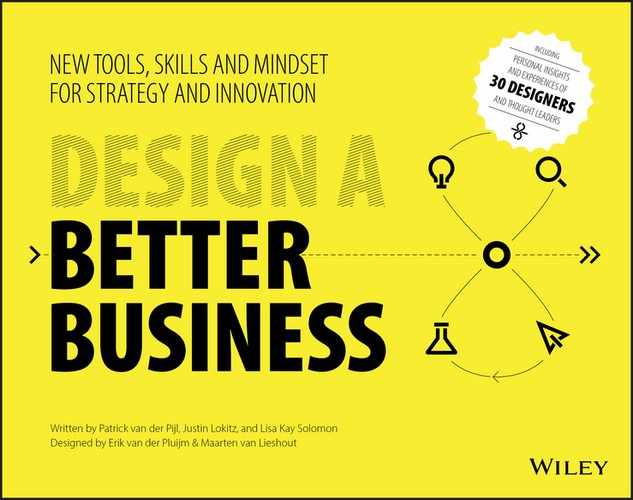Page 216
WHEN TO SCALE
Whether you embark on the design journey as a startup or an existing company, one thing is certain: it’s a roller-coaster ride, and it doesn’t end when you come up with an idea. It’s a journey that is meant to scale both the design process and the execution of the idea.
THE END OF THE LINE
This is the last leg of the journey . . . well, this journey anyway. After going through the double loop, designing a better business, and learning from your customers, the world, and yourself, you should give yourself a hand. You did it! At least once.
Now buckle up, it’s time to get back on the ride.
Designing one innovation is not enough. It’s simply not a one-off thing. As with any profession, design takes practice. Doing it over and over will lead to mastery. Only then will the practice of designing for better business become a mindset.
DISTRUST KILLS INNOVATION.
RIGGING THE GAME
Rigging a game will turn the numbers in your favor; using design processes to build better businesses will improve your odds (and your organization’s odds) of success. A design mindset that favors understanding, ideation, prototyping, and validation will allow you to execute and scale. Best of all, when you start to develop this mindset and see the world through your own design-colored glasses, you’ll find that not only are your odds better, but you’ll also be able to confidently bet on multiple games at once.
If recent history has proven anything, it’s that organizations that build this drive for exploration and learning into their DNA are the ones that have the best chance to turn uncertainty into opportunity. They are the ones that successfully rig the game in their favor. And it’s never too late to start.
LEARN FROM OTHERS
So, how can we scale up from one successfully designed outcome to incorporating design into our core culture? The best way to start is to learn from others’ journeys, successes, and failures. In this chapter we’ll explore and evaluate a number of approaches to scale design.
We’ll look at a special co-working space, a successful accelerator, a large bank setting up an innovation lab of their own, and a large energy company building design capacity through acquisitions. We’ll also look at a couple of large software companies using the design process to embed this mindset into their respective cultures.
Page 217
TIP! Think about not only scaling design, but also scaling the network of people your team will need to tap into to get better answers to their questions.
INGREDIENTS
There are four main ingredients necessary for scaling design within your own organization.
First and foremost, we’ve said it before and we’ll say it again, don’t go it alone. To scale design you’ll need to build a network and find ways to tap into it. You need access to customers; talented, like-minded people; feedback; experts; and even investors. Anyone can put on a cape with a giant “D” printed on it. But without a network, you’re just a guy with a stack of sticky notes and a marker who’s wearing a cape to work.
Second, you’ll need support for your design endeavors. As Maurice Conti from Autodesk stated, you must have a direct connection to management when embarking on the design journey. This will give you access to the resources you need, like time, space, funding, people, etc.
Third, you’ll need quick access to practical knowledge. A validated methodology, like the one laid out in this book, will go a long way in helping you gain the support you need to move forward. But you also need to learn from others who already have made a lot of the mistakes implementing the methodology.
The final, most important ingredient is trust. You’ll need to trust the process. And you’ll need others to trust you, so that you can feel empowered to make mistakes, take risks, and fail (in small ways) in a fail-safe environment. For most existing companies, this trust is hard won. But it is so so very worth it. Why? Distrust kills innovation. And with distrust comes detailed budget scrutiny and time-clock behavior.
ARE YOU INVESTMENT READY?
We have included Steve Blank’s Investment Readiness Level (IRL) as a way to gauge where your company is right now and what the next steps might be as you drive toward a successful sustainable business. ![]()
TIP! To scale you’ll need a direct line to management. This is where ambassadors really help.
See the Investment Readiness Level on page 244
Page 218
THE CONTINUUM OF SCALE


THE END OF THE LINE
Scaling is something that you do when your simple idea is ready to fly into full-on execution mode. For existing companies, execution all too often signals the end of the design process. For startups still searching for their sustainable business model, scaling is about building a bigger, better product, perhaps one that finally makes money.
Startups never stop following the double loop; they continue validating and adjusting their point of view based on evolving understanding about their customers.
Page 219
DESIGNING SCALE
What we mean when we talk about scale is more akin to the startup: scale is about tackling a different problem, raising the stakes, and continuing the design journey (as a culture). Scaling is about using the same process described in this book to figure out how to scale the process to an entire organization of people, wanting and needing better ways to create opportunities from uncertainty. How meta!
There are many ways to scale design in an organization. However, although this book describes tools to design and innovate businesses, scale is less about specific tools and more about an organizational mindset. Because each organization comes with its own cultural constructs and unique challenges, opportunities, and makeup, there is no one perfect process or tool for scaling. Rather, scaling permeates an organization’s culture such that design tools flourish. ![]()
